Guest Columnist
Medium
February 28, 2015
An October 14, 2014 article from The Oregonian told a familiar story line that is now being used to push through an “emergency” measure in Oregon—Senate Bill 442–3—that would remove both philosophical and religious vaccination exemption rights for parents. If passed, Oregon would join only West Virginia and Mississippi with such a sweeping vaccine mandate: if children don’t get every shot on Oregon’s schedule, including every booster, they can’t attend any kind of school. The article, written by Lynne Terry, started with a headline that’s hard to miss:
Oregon — yet again — has highest rate of unvaccinated school children, CDC says
The article went on to explain:
“Oregon has retained its ranking nationwide as the state with the highest number of unvaccinated school children. The Centers for Disease Control and Prevention said Thursday in its MMWR report that the latest exemptions rates range from 0.4 percent of kindergarteners claiming a nonmedical exemption in Virginia and Washington D.C. to a high of 7 percent in Oregon. The state has a relatively low number of students claiming a medical exemption — 0.1 percent.”
The only problem with this article is that it is factually incorrect. It’s unlikely that Lynne Terry was trying to deceive anyone: the data is just very confusing.
Here’s the truth about Oregon’s vaccination rates.
- Oregon Vaccine Exemption Data: Double-Counting, Unreliable, and Confusing
The purpose of this article is to present Oregonians with facts and only facts, and all the facts in this article have been derived either from the Oregon Health Authority (OHA) or the Centers for Disease Control and Prevention (CDC). The first fact and probably the most important one concerns how vaccine exemptions are captured here in Oregon:
Fact #1: There are 23 vaccines that are required for children to attend school in Oregon. The parent of a child who has received 22 out of 23 vaccines has to sign an exemption for the 23rd shot, and their child is counted by the OHA as “exempt.” A parent whose child receives 0 out of 23 vaccines is also counted as exempt, as is a child who receives 12 out of 23 shots. Because shots are given as a series — for example, Oregon requires six separate DTaP shots — the data runs amok. Children who are mostly vaccinated are then misconstrued as “unvaccinated.”
There are a number of ways to support Fact #1. The first way is to look at the confusing form that has caused most of this misunderstanding. It’s a two-sided form that shows every shot and every shot within the series that every school-going child is expected to get. Numbers have been added in so you can easily see the number of shots recommended (23 as of 2014). The front of the form includes all the “mandatory” shots and the back of the form includes just “recommended” shots. Most parents probably think their child needs to get all the shots to attend school, because it’s not spelled out anywhere on the form. (It says “recommended” on the back, but nothing on the front.) At any rate, here’s the form:
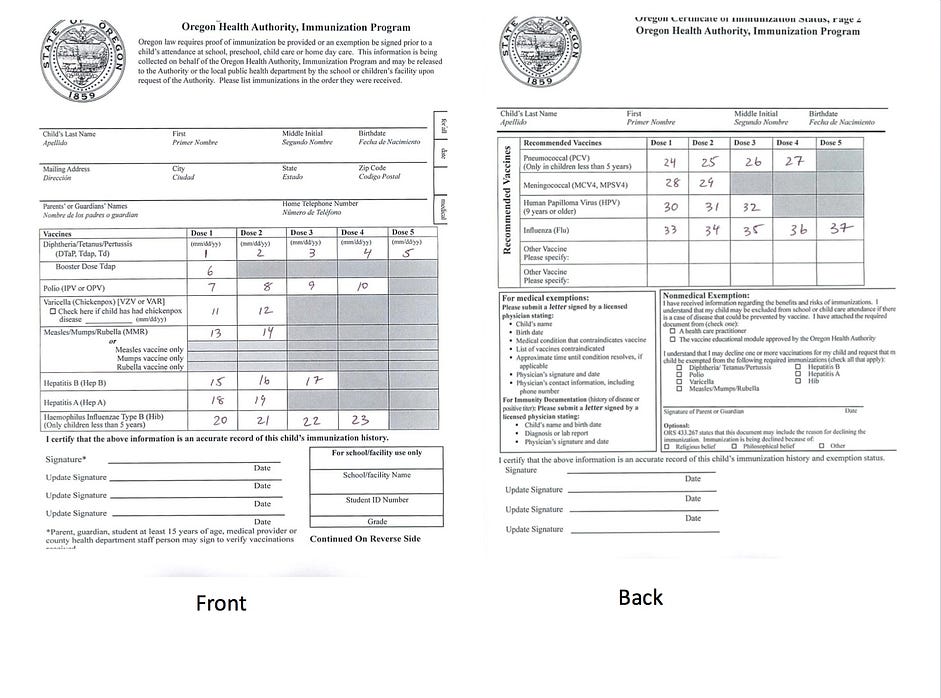
(*One pet peeve about this form: Separate vaccines for measles, mumps, and rubella have not been available since 2008…why are they still on the form?)
As you can see, there are 23 “required” shots for children to attend school in Oregon, and and another 14 recommended, for a total of 37 shots. There’s an easy way to show all this by looking at three theoretical examples of how this form could be filled out:
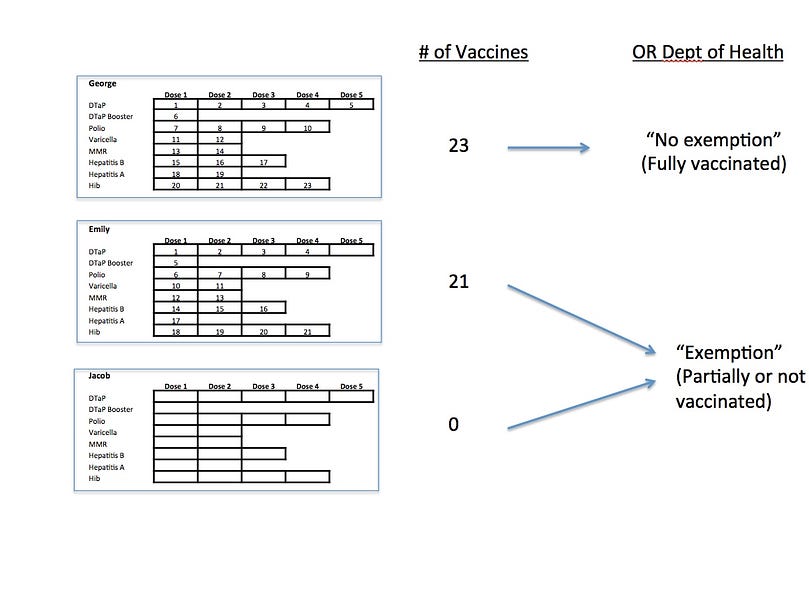
George receives 100% of his shots and is therefore not captured as an exemption. The problem is that Emily and Jacob—one of whom received every shot on the schedule but not every booster (and immunity is typically conferred after a single shot)—are both classified by Oregon as “exempt” and misclassified by proponents of SB442–3 as “unvaccinated.”
Emily, like the overwhelming majority of children who are classified as “exempt,” is what makes the exemption data useless. Because Emily received her first four DTaP doses , she would be captured in state and CDC data (more on that in a moment) as “vaccinated” for DTaP, while also counted by Oregon Dept. of Health and proponents of SB442 as “exempt” and than further twisted into “unvaccinated.” In short, she is double-counted. Think of this another way:
If there’s a pediatrician’s office in a small county somewhere in Oregon and they pretty much see all the children in that county. If they have been giving children in their practice 4 doses of DTaP, but not six, then every child in their practice would be counted as “exempt.”
Hopefully, this misuse of exemption data now makes logical sense. We confirmed that this is the correct way to look at the data through three means:
- (i) The Oregon Health Authority confirmed it to us.
In preparing this article, we called the OHA and were directed to the expert on exemption data who will remain nameless. We took notes during our conversation and here’s how it went:
Us: “If someone gets 5 out of the 6 required DTaP shots, do they just sign an exemption for the final shot”
OHA: “Yes”
Us: “So is this child, who got 5 out of 6 DTaP shots and whose parents signed the exemption for just one shot, counted as ‘exempt’ on the county-level exemption data?”
OHA: “Yes”
Us: “So does that mean a child who received their MMR would be counted as vaccinated for MMR but then counted as exempt for DTaP even though they got 5 out of 6 shots. And that they would contribute to the ‘exempt’ classification in exactly the same way as a child who received zero shots?”
OHA: “Yes.”
- (ii) The Oregon Health Authority confirmed it in the media:
“The Nonmedical Exemption County number includes children with a nonmedical exemption for all required vaccines, and children with a nonmedical exemption for one or more vaccines who are up-to-date or complete for vaccines for which they do not have exemptions,” according to the Oregon Health Authority.
- (iii) The Oregon Department of Health data on vaccinated children and exempt children often exceeds 100%, which means children are being double-counted
There is a single document, available from the OHA here, that is the source of 99% of the confusion about exemptions, and contains the data that proponents of SB442–3 have interpreted with the consequence of imagining a problem that doesn’t exist. We’re going to pull out data from one page of this 7-page document so you can see how it double-counts partially vaccinated children and counts them as “exempt.”
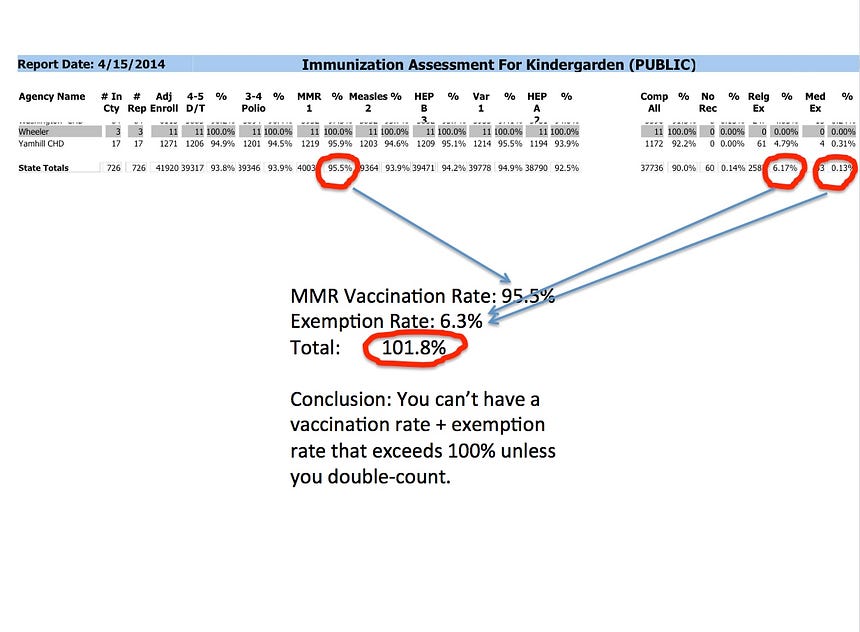
As you can see, because it is rife with double-counting, the exemption data from the OHA makes it nearly impossible to understand the true vaccination status of Oregon children. Luckily for all of us, there are two ways to find data about the vaccination status of Oregon’s children: One set of data comes from the OHA and one set of data comes from the CDC. Why haven’t you heard more about these rates, which are all well within the national averages? That’s easy:
Because they don’t help support the fictional narrative created to support SB442–3.
Before we move past the exemption data to focus on actual immunization and disease rates, let’s review the Oregonian article that opened this report. Remember the claim that “7% of Oregon’s children are unvaccinated”? Well, it comes from this map available on the Oregon DOH website:
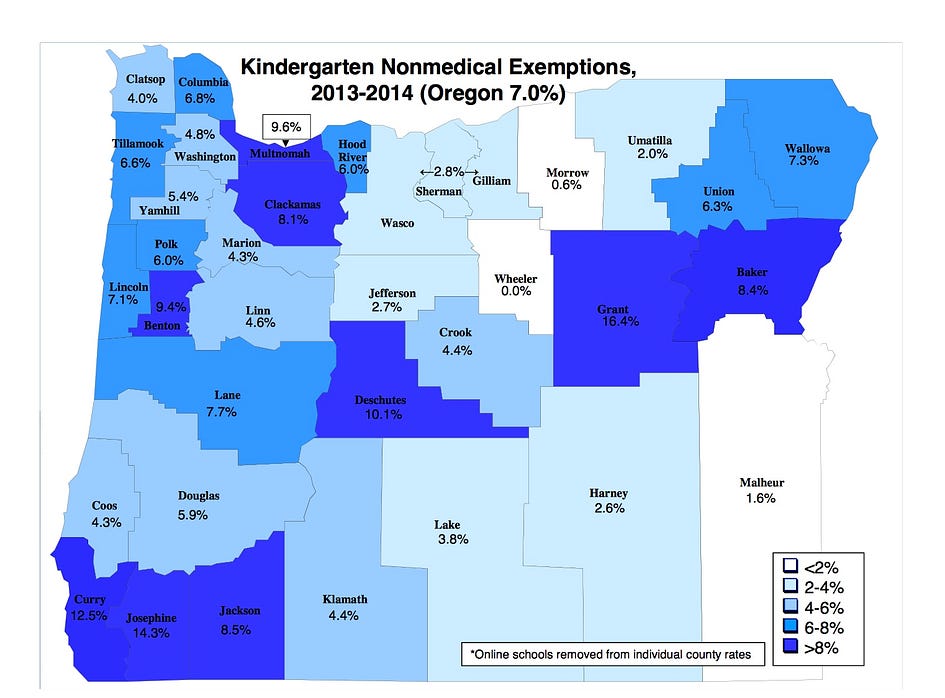
By now, hopefully, you realize this data tells us almost nothing because the vaccination data of each child isn’t being accurately captured or reported. Just to be skeptical for a moment, though, how can it be that Grant County and Wheeler County, bordering each other, have exemption rates of 16.4% and 0%, respectively? That just doesn’t make any sense in the real world. It’s simply another way to highlight the final conclusion of this lengthy, and probably very boring, review of exemption data in Oregon:
“Exempt” in Oregon does not mean “unvaccinated.” Because of how data is captured, it’s rife with double-counting and inaccuracies. This is a product of the form used and the system utilized for capturing the data. We’ll give a simple example: We talked to a friend the other day about this form. They recollected having to fill out this form. They were busy that night, couldn’t locate their child’s shot records, realized they could just sign the exemption, and did so. So, their almost completely vaccinated child ends up being counted as “exempt” by the State of Oregon and “unvaccinated” by Lynne Terry of the Oregonian, and then the 7% number of exempt children is used by proponents of SB422–3 to declare a state of emergency.
You thought you were done with exemptions, right? But, a reader brought up a secondary talking point used by the proponents of SB442–3 that must be addressed: the idea that exemption rates are rising over time. Their argument is that this pernicious trend must be snuffed out before epidemics start happening, and the only way to do this is to take away parental rights and make vaccination, a medical procedure, mandatory. Because this is a “health emergency”, the otherwise fairly obvious civil rights violation of removal of informed consent can be justified because, according to them, public health is in imminent danger. However, a close look at the numbers shows a far more likely reason for the increase in exemption rates over time.
Below is a slide from a presentation in 2012 given by Lorraine Duncan, the Oregon Immunization Program Manager at that time. It shows, quite clearly, that exemption rates have been growing. What’s also true is that exemption rates by shot have not been captured by the OHA until 2012 (and then only for kindergarten), so no one could be certain what’s driving the increase.
The most likely reason is pretty simple: When new vaccines get added to the mandatory schedule, exemption rates rise.

As you can see in the graph, the OHA has added shots to the schedule over time, and growth in exemption rates tends to match these additions.
It makes sense: Whether a parent simply fell behind on knowing the new vaccine requirements, had a doctor who advised them to hold off before adding a new vaccine, or had a general wariness about adding a shot like hepatitis A , which is mandated in only 20 states — and in zero European countries. We may never be able to tie this all together, but the rise in exemption rates may be far less “pernicious” than people think. Once again, and luckily for all of us, vaccination data is captured in a different way that clearly and unequivocally demonstrates that the “state of emergency” SB442 proponents are declaring is well…complete fiction. We’re finally on to Fact #2 (and they are all much shorter from here)!
Oh, and if you’re still not sure if this is all plausible, that really who knows about all this exemption stuff, consider that, back in 2012, Lorraine Duncan, former head of Oregon’s Immunization Program, knew clear as day what all the exemption stuff really means because she wrote about it in her own presentation (with editorializing in the boxes). Note that “religious exemptions” means religious or philosophical exemption, since in Oregon those have been combined:
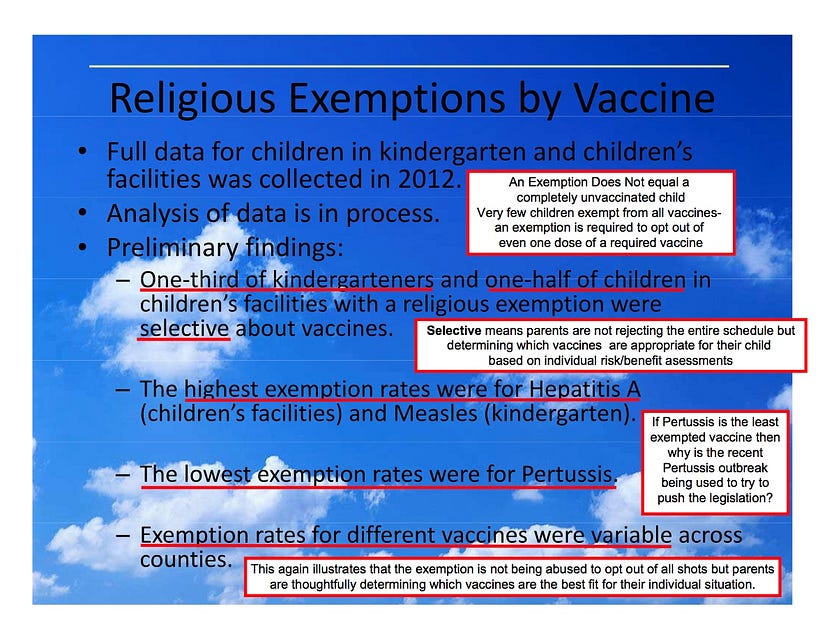
2. According to the CDC’s National Immunization Program, Oregon meets or exceeds vaccination levels for every shot mandated in the State of Oregon
The CDC’s National Immunization Program is the gold standard for reporting national vaccination levels. The data is readily available, and according to them, Oregon is doing just fine and dandy when it comes to vaccination rates.
Here’s the page on the CDC website where you can pull all this data. If you click on the table under their most recent data set, January-December 2013 and then click for overall data, you will arrive at this page. At the top of this page, you will find NIS Table Data for 2013, and you can download the excel file or pdf for yourself. If you do this, and you choose to crunch the numbers, here is what you will find out, and it’s really very straightforward:
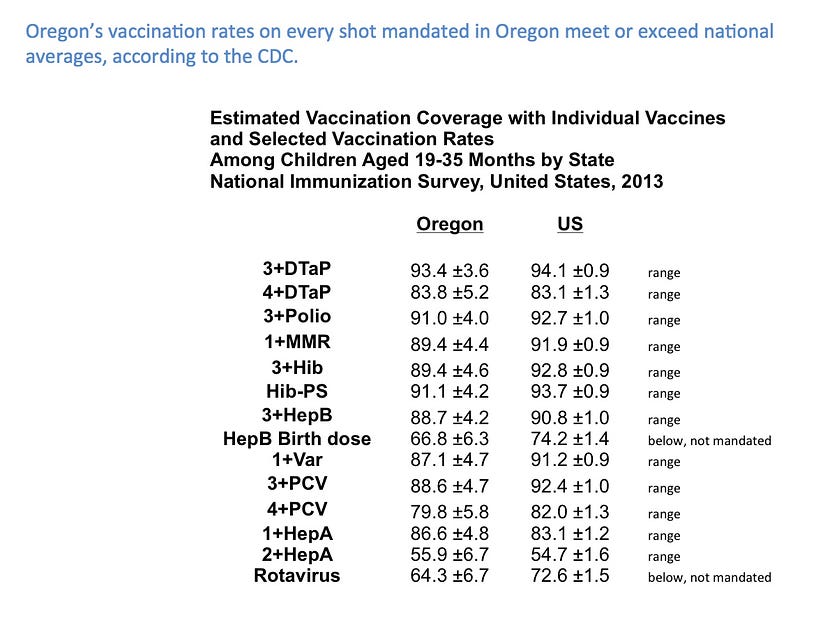
Not much else really needs to be said as the data set doesn’t lie: according to the CDC’s data, Oregon is not in a state of emergency for having low vaccination rates.
I’ve mentioned Lorraine Duncan and I’m going to keep mentioning her again. You see, we’re sitting on a copy of a presentation she gave in 2012, extolling how WELL Oregon’s Immunization Program was doing. One of the slides she proudly showed concerned measles, mumps, rubella (MMR) vaccination coverage in Oregon, and guess who’s data she used to show it? Good guess, the CDC’s National Immunization Survey:
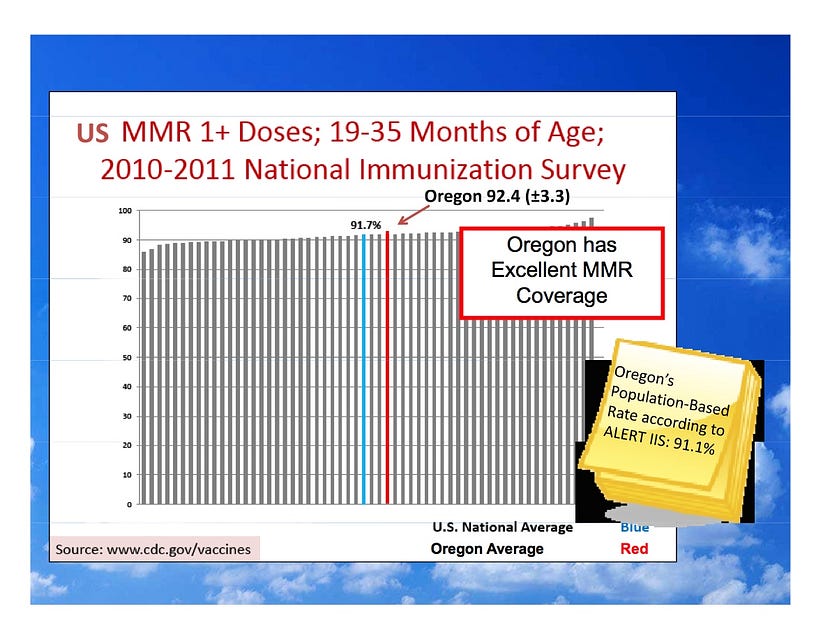
Fact #2: According to CDC data that Oregon’s own Immunization Program Manager quotes proudly, Oregon is doing great compared to the national average in terms of overall vaccination rates for EVERY mandated shot.
3. According to state health officials here in Oregon, Oregon’s vaccination rates are at all-time highs
We keep mentioning Lorraine Duncan, here’s a copy of the first page of a presentation she gave in 2012: 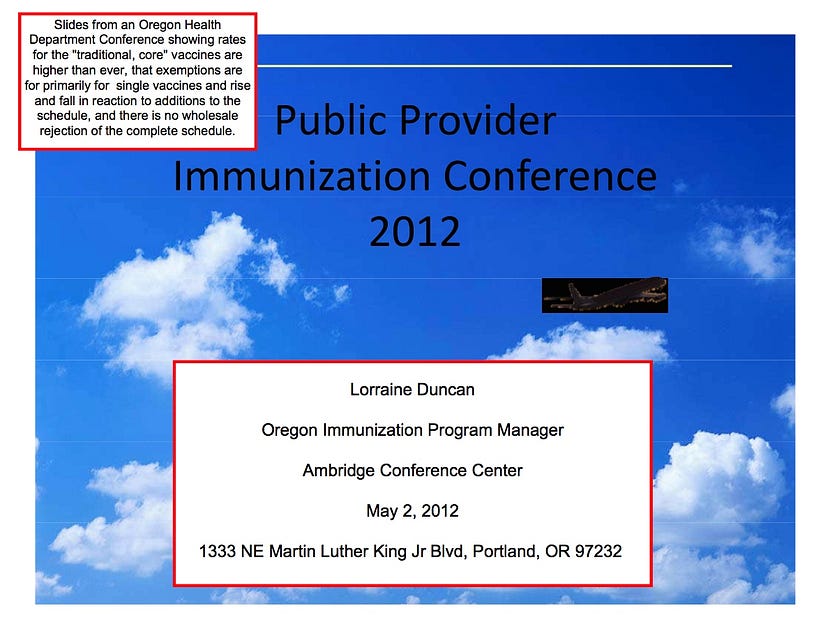 Her presentation reads like a “home run trot” of public health accomplishment, and includes the following slide:
Her presentation reads like a “home run trot” of public health accomplishment, and includes the following slide:

Some notes have been added to her slide. This presentation used an airport terminal theme to spice things up, and Duncan is extolling the public health accomplishments here in Oregon that include:
- Record low VPDs (Vaccine Preventable Diseases)
- Achieved and sustained high childhood immunizations
Wait a minute. Record low disease? “Sustained” rates of high childhood immunization rates? But…what about the state of emergency? (We will look at measles data in a second, which confirms everything Ms. Duncan is saying.)
Let us take a breath here and highlight a point because it’s really important:
Lorraine Duncan is telling the truth in her presentation. Vaccine preventable disease is at an all-time low in Oregon. Vaccination rates are at all-time highs. This is great news! Frankly, as a public health official she has every right to brag about where things stand in Oregon, because she and her team are doing a great job. Ms. Duncan’s presentation, delivered so recently (less than 36 months ago), crushes the “state of emergency” contention of SB442–3 proponents. We know the Senate Committee on Health Care & Human Services is meeting about the “state of emergency” on March 9, 2015. Can someone promise me that Ms. Duncan and this presentation will be there, too?
Ms. Duncan was so excited about Oregon’s excellent immunization rates, that she went on to show that the state is well ahead of vaccination rate goals for 2020:

Above, I mentioned how the CDC’s National Immunization Survey is a sort of gold standard for national- and state-level immunization rates. Oregon, however, has its own vaccination rate data, all provided by the Oregon Health Authority. You can find a complete summary, by year, right here. This data is derived in a completely different way from CDC, using a system called ALERT that relies on medical records here in Oregon. It happens to be highly corroborative with CDC findings, which of course makes the conclusions fairly robust and reliable. And, here’s what it looks like:
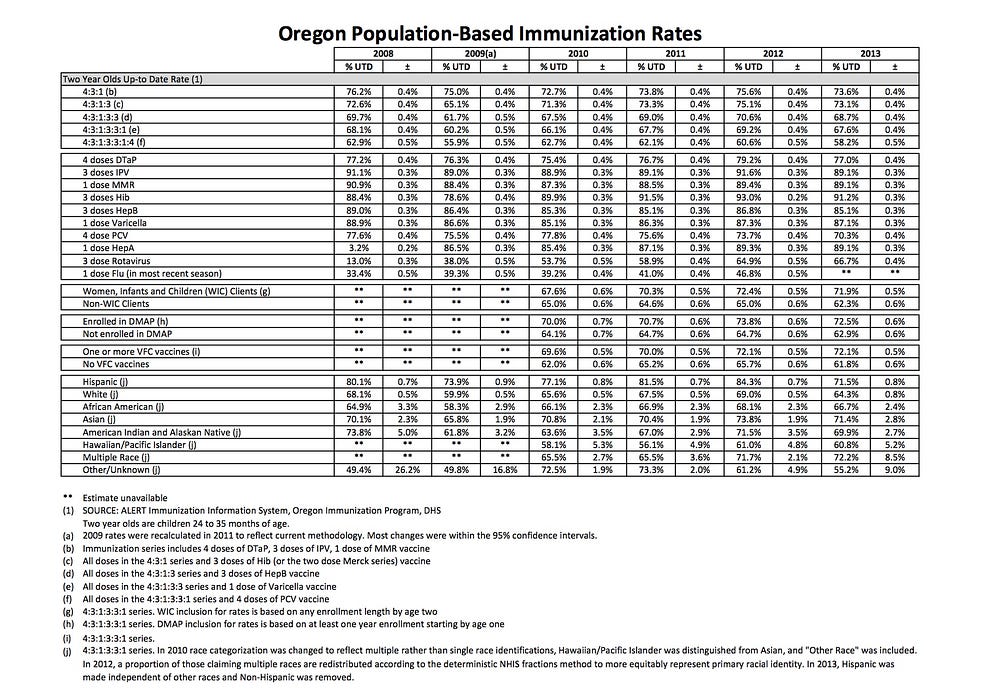
We’re going to try and say this in the nicest and least snarky possible way: if you are a fan of SB442–3 and part of your argument is that “vaccination rates are on the decline” and we need to “declare a state of emergency” before things go South, than you better hope the Department of Health removes this data and then disowns it. Within any moderately reasonable margin of error, there is simply nothing here to tell you that anything about immunization rates is declining or at risk, which is why Lorraine Duncan could proudly state in her presentation that the Oregon Immunization Program has “Achieved and sustained high childhood immunizations [rates].” Because they have!!
Just for fun, we pulled Jackson County data from Oregon’s own data. Jackson County is home to the much maligned Ashland and Medford, which, if you read the news, you’d think was a leper colony of unvaccinated kids ready to start the next bubonic plague. Surprisingly, Jackson County exceeds Oregon’s statewide immunization rates on many vaccines!
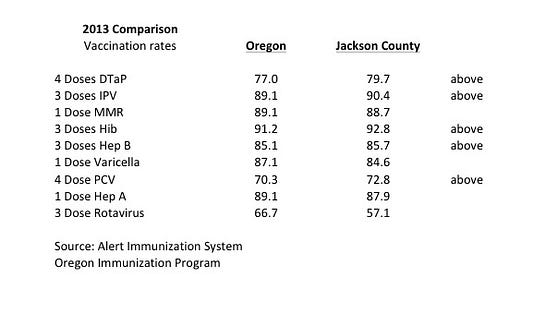
Fact #3: Oregon’s immunization rates have been consistently high, according to both the head of the Oregon Immunization Program and Oregon’s own data, compiled through their ALERT system and freely available on the OHA’s website. Nothing about current immunization levels appears remotely like a “state of emergency” and a balanced review of Oregon’s own data calls into question what data SB442–3 proponents are looking at—and why they are creating needless hysteria.
4. Oregon has not had a measles outbreak in more than 20 years, and infectious disease data supports what Lorraine Duncan said: the vaccination program in Oregon is working
The Disneyland measles outbreak has created considerable hysteria, despite that fact that national measles rates have been steadily low for a long time, including 2015:

And, much like Oregon, immunization rates of MMR vaccine have also remained very stable:

Oregon’s data for measles is even more supportive of Ms. Duncan’s conclusion that the sytem in Oregon is working, the state hasn’t had more than 10 cases of measles in any year since 1991, 24 years ago (and in the early 1990s, the immunization program was considerably less developed than it is today):

In fact, measles (and mumps) are so rare in Oregon they are considered “low incidence conditions” by the Oregon Department of Health and there were actually more cases of dengue fever in Oregon in 2013 than there were of measles (and taeniasis—a tapeworm infection—blew them all away in 2009):

Fact #4: Oregon had one confirmed case of measles during the Disneyland measles hysteria. There has not been an outbreak of measles in Oregon in the last 20 years, and immunization rates for measles/MMR meet or exceed national averages. Are these really the kinds of numbers that condone the sponsors of SB442–3 declaring a “state of emergency”?
5. The policy decision that the proponents of SB442–3 are advocating to respond to an emergency that doesn’t exist makes little sense.
It’s already been clearly demonstrated that Oregon has had a clear and sustained rate of immunizations for all major diseases and no material outbreaks in two decades.
Yet, a certain group of legislators on the Senate Committee on Health Care & Human Services are recommending a set of changes to Oregon’s health laws that can most politely be referred to as “draconian”:
- Remove both religious and philosophical exemptions from Oregon’s vaccine policy, effectively creating mandatory vaccines for any parent who wants to send their child to school in Oregon
- Only two states in the union have a policy this draconian: West Virginia and Mississippi. Which raises a great question: how are their immunization rates? Referring back to the National Immunization Program, you can crunch the data for any state. And what does it tell us?

Huh? Shouldn’t Mississippi and West Virginia be #1 and #2 for vaccination rates? Well, they aren’t. And, if they aren’t, maybe this isn’t such a great policy idea, anyway? Maybe we should look at states who are in the top 10, all of whom have either religious or philosophical exemptions, and see how they do things.
Regarding mandatory vaccinations, we haven’t even mentioned:
- No other first world country mandates vaccines and takes the right of medical care away from parents and hands it to the state
- SB442–3 destroys medical ethical principles that the American Medical Association and many others hold for their own physicians
- SB442–3 crosses a highly problematic civil rights line that many Oregonians find outrageous and dangerous: a loss of medical freedom and a loss of informed consent and parental rights
But, let’s not even touch the myriad of civil rights issues this bill raises, let’s just ask if it’s good policy. Mississippi is #1 for child mortality and dead last for overall health. Is this really a good idea? Here’s another group’s points, the United Health Foundation, just focused on philosophical exemptions, and comparing those to public health in other states (note Oregon tied for 8th for low infant mortality and middle of the pack for immunizations):

Everyone needs to realize, SB442–3 destroys the fragile doctor-parent trust model and will also penalize many well-meaning parents who may feel great about protecting against Measles, Polio, and Whooping Cough, but have reservations about the need for the Hepatitis B shot or Flu shot. If your logic for approaching vaccines looked anything like this, your child can’t go to school in Oregon if SB442–3 passes:

And, while we’re at it, did you know how much bigger the US vaccine schedule is than every European country? Are you sure you want the state to be in charge of how we all approach vaccines?
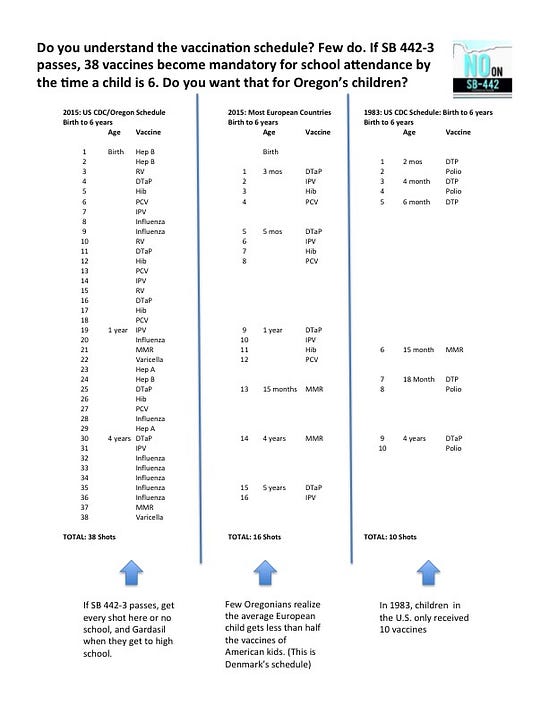
Note: Oregon does not YET mandate every shot on the CDC schedule above, just most. However, Oregon tends to adopt whatever CDC recommends. As an example, Oregon mandates Hepatitis A vaccine, even though only 15 other states do the same. If parents no longer have opt-out rights, it’s reasonable to assume that Flu and Gardasil will move from “recommended” to “mandatory” very soon.
When you look at more recently developed vaccines, the U.S. is always the first adopter, many other first world countries are far more careful about when they add new vaccines to their childhood schedule. Look how no other countries have adopted Hepatitis A (and not even half the U.S. states), and very few have added Rotavirus, Varicella (chicken pox), or Flu. Also, while many countries immunize for Hep B, the U.S. is the only country that does it for ALL children, other countries only do it for children born to Hep B-positive mothers:

With the pharmaceutical industry proudly proclaiming they have over 300 vaccines under development, are we all sure we want to hand the state the right to mandate vaccinations?

6. Legislator warning for March 9th
We’ve received an anonymous tip that the proponents of SB442–3 have told the Oregon Department of Health that they expect a representative to show up to their working group meeting that day with a data set that supports the draconian and emergency measures SB442–3 advocates.
If you have read this entire article, you appreciate what a challenging order that is for the Department of Health, particularly Lorraine Duncan who is on the record extolling her program’s accomplishments. But, don’t think they won’t try! Data presentation to support SB442–3 will likely rely on two particular story lines:
- Overall exemption rates, and the implication that exemption=unvaccinated, which you know and the Department of Health knows is just untrue.
- Growth of exemption rates over time, which don’t happen to match declines in immunization rates over time
- And, probably the only data they will have left to work with: “pockets” of higher exemption rates at certain types of small schools. There are a handful of schools with much higher exemption rates than Oregon averages. Of course, because of the way data is collected we don’t really know why. Maybe all the Waldorf parents at a certain school spread the word that the risk/reward for the newly added Hep A vaccine wasn’t worth it. Maybe they all see the same doctor. If you have a “micro” issue, why utilize a blanket solution? It makes no sense. Especially when the data you have doesn’t even explain why decisions are being made.
Hopefully, the information contained in this document will make the Department of Health’s task even more challenging, and we sure hope Ms. Duncan, who has done an excellent job for Oregon, will be part of the hearing.
You see, Ms. Duncan retired in 2013, but is remembered fondly:
After building a statewide agency from scratch, Lorraine Duncan has made an indelible imprint on Oregon’s Immunization Program.
Today, Oregon takes in $50 million each year — primarily from the Centers for Disease Control and Prevention — so that thousands of adults and children can get the vaccines they need to stay healthy, thanks to Duncan. “I know $50 million is a lot of money, and we’ve been very careful stewards of those dollars,” she said.
Physicians across the state — many of whom are pediatricians — as well as public health departments, rural health centers and federally qualified health centers receive those vaccines….
…After leading the agency for the past 33 years, Duncan, 66, has retired. But her dedication and stamina have earned her plaudits as a super star on the national immunization stage“I’ve really appreciated having one of the best immunization program managers in the nation right next door,” said Janna Bardi, who runs Washington State’s immunization program.
Lorraine Duncan, a venerable “super star on the national immunization stage” has built a system so robust that we find ourselves in a state of emergency? You think she’d be surprised, less than two years after her retirement, that a group of state Senators are saying that the system she built is effectively broken?
Something doesn’t add up, on that we can all agree.
For the companion article to this, please read: Who cried wolf in Oregon?
a revealing look at who sounded the alarm in Oregon to create an “emergency” mandate
This article was written by several well-meaning Oregonians who are big fans of medical freedom and informed consent who apparently have nothing better to do than crunch numbers. We have nothing to gain or lose financially from the passage of this bill. We have proudly joined a movement of a few thousand Oregonians fighting this legislation, the organizing website can be found here: www.NoOnSB442.com
